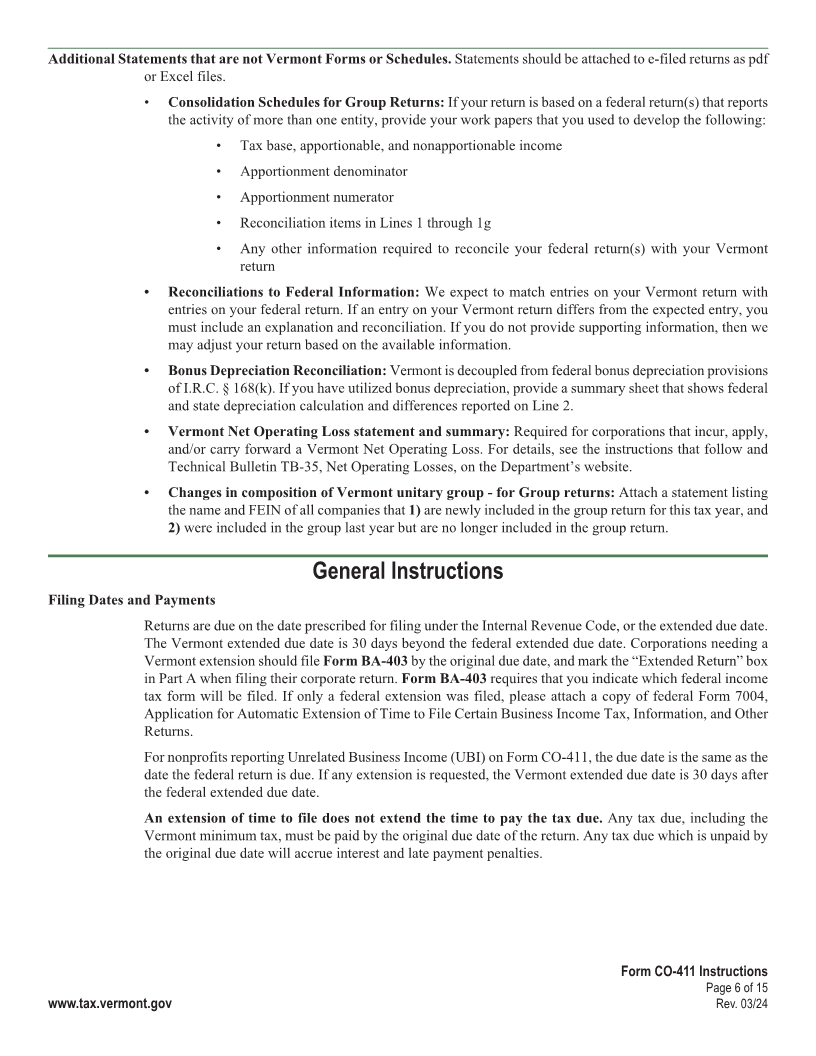
Enlarge image
FORM CO-411 Instructions
Corporate Income Tax Return
Page 1
Please print in BLUE or BLACK ink only.
Effective January 1, 2023.
Effective for tax years starting January 1, 2023, and later, Vermont adopts the Finnigan Method for unitary
groups. Under Finnigan, the entire group will be treated as one taxpayer. Therefore, if the parent or any
affiliate engages in activity that breaches the narrow scope of protections afforded under PL 86-272, then
the entire group is taxable. In that case, all sales into Vermont must be included in the numerator regardless
of which member of the group incurred them. Generally, Vermont agrees with the positions adopted by the
MTC on August 4, 2021, regarding the scope of the protections of PL 86-272.
Act No. 148 (S.53). Taxation; Corporate Income Tax; Conformity to federal tax laws. All changes
are effective January 1, 2023. This act includes four sections that change the way multi-state companies
apportion income to Vermont and restructures the corporate minimum tax. The four changes of this corporate
tax reform package include:
INSTR (Place at FIRST page)
• Move to Single Sales Factor Instr. pages
○ Vermont no longer uses a three-factor apportionment formula (sales/property/payroll). It now
considers only sales into the state.
• Repeal Throwback Rule
○ Vermont sales factor no longer includes sales from Vermont to the federal government or to a 1 - 16
state where those sales are not taxable.
• Move from Joyce to Finnigan
○ “Joyce” and “Finnigan” represent two different methods to determine nexus and the calculation
of in-state activity of unitary groups.
○ The Finnigan approach looks at the unitary group as a whole and treats the group as one
taxpayer - either having nexus with the state or not.
• Repeal Exclusion of 80/20 Companies in Unitary Group.
○ Requires all US corporations to now be included in a unitary group.
Special Considerations: The passage of these recent statutory changes supersedes any conflicting passages
within our previous unitary regulations (Vt. Reg. § 1.5862(d), The Department is working on updating these
regulations to incorporate the statutory changes. Regulations that do not conflict with current law continue
to apply.
Reminders and Additional Information
You may be required to e-file your return. Please review the mandate before mailing a paper return. We may Instructions have NOT
reject your paper return or assess a fee. Search for “e-file mandate” on our website at www.tax.vermont.gov
for detailed information.
Be sure to use the myVTax taxpayer portal www.myvtax.vermont.gov to your best advantage. MyVTax
users spend less time on the phone and conduct business with the Department of Taxes far more efficiently. been edited for 2015 yet
After setting up an account, you can make payments, file your extension, verify prior returns, verify estimated
payments, view letters that we sent, communicate securely with the Department, and more. You can provide
third-party access to others such as your preparer or payroll service. Even if you haven’t yet set up an account,
Form CO-411 Instructions
Page 1 of 15
www.tax.vermont.gov Rev. 03/24














